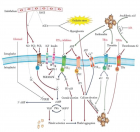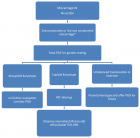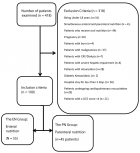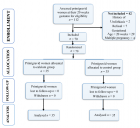About Federal University of Minas Gerais
Federal University of Minas Gerais
Articles by Federal University of Minas Gerais
The Renin-Angiotensin System: Alamandine is reduced in patients with Idiopathic Pulmonary Fibrosis
Published on: 20th November, 2019
OCLC Number/Unique Identifier: 8440576482
Idiopathic Pulmonary Fibrosis (IPF) is a chronic and progressive disease without treatment that leads to death. Therefore, to control its progression to pulmonary hypertension is still a challenge. Moreover, there is no study that has investigated the Renin-Angiotensin System in patients with IPF.
Objective: Verify the plasma concentrations of Angiotensin I, Angiotensin II (AngII), Angiotensin-(1-7) [Ang- (1-7)] and Alamandine in patients with IPF.
Methods: Ten IPF patients, with or without PH, were included, and ten controls matched by sex and age. Quantitative plasma peptide concentrations (PPC) were expressed as mean and standard deviation or median and interquartile range. The Student Newman-Keuls t test was used for parametric data, Mann-Whitney for nonparametric data and, to compare proportions, the Fisher exact test was performed. The associations between clinical variables and the PPC were evaluated by Pearson or Spearman correlation coefficients. A p ≤ 0.05 was considered statistically significant.
Results: The Alamandine plasma concentration was significantly (365%) lower in the IPF group and positively associated (r = 0.876) with pulmonary artery pressure (PAP). In addition, only in control group, the forced expiratory volume (FEV1%) was positively associated (p = 0.758) with Ang-(1-7).
Conclusion: This study showed, for the first time, that there is a decrease in Alamandine participation in patients with IPF. The ACE-AngII-AT1 axis may be more active in this disease. In addition, our results suggest that Alamandine might be compensating the increase in PAP, as well as the Ang-(1-7) is improving the forced expiratory volume.
Study of ESG criteria and metrics for the construction industry
Published on: 11th October, 2022
Considering the performance of supply chains in the three dimensions of sustainability; Economic, Social, and Environmental, ESG scores can function as a measurement scale [1]. Environmental, social and corporate governance (ESG) is an extension and enrichment of the concept of Socially Responsible Investment (SRI) and is an important measure of corporate sustainable development [2,3].
ESG (Environmental, Social and Governance) in construction civil: concept that can contribute to the sector
Published on: 11th October, 2022
The search for a sustainable development path capable of satisfying the needs of the current generation without compromising the well-being of future generations is not a new challenge. In recent years, climate change and, more generally, the transition to a sustainable development model have become increasingly important. According to the European Central Bank [1], guidelines on sustainable finance, a company aims to develop value by adhering to relevant ideals, such as fair remuneration for employees, respect for ethical and social values and preservation of the environment.
Intrauterine Therapy with Platelet-Rich Plasma for Persistent Breeding-Induced Endometritis in Mares: A Review
Published on: 10th December, 2024
This review aims to emphasize the scientific focus on platelet therapies by presenting the results already obtained in mares susceptible to Persistent Breeding-Induced Endometritis (PBIE), as well as highlighting opportunities for further improvement. The recent publication demonstrating the absence of bacterial growth in susceptible mares treated with PRP underscores the potential of regenerative therapies to control infections without promoting the emergence of multidrug-resistant bacteria. Alternative therapies have gained prominence in the current public health context, with the World Health Organization listing antimicrobial resistance among the ten most significant global threats. Endometritis is the leading cause of subfertility in mares, and empirical antibiotic therapies are commonly used in the field due to market pressures related to the high financial value of embryos, along with logistical challenges in obtaining laboratory-dependent diagnostic results. Platelet-Rich Plasma (PRP) is an alternative therapy derived from whole blood plasma with a high concentration of platelets. Its anti-inflammatory, regenerative, and antimicrobial properties are particularly tested when traditional therapies fail to achieve the desired effect. In recent years, research on the use of PRP in equine reproduction has primarily focused on endometritis, with a particular emphasis on persistent breeding-induced endometritis (PBIE). However, there is a growing interest in other platelet derivatives, such as lyophilized platelet-rich plasma and platelet lysate, which offer practical field applications.

HSPI: We're glad you're here. Please click "create a new Query" if you are a new visitor to our website and need further information from us.
If you are already a member of our network and need to keep track of any developments regarding a question you have already submitted, click "take me to my Query."




















































































































































